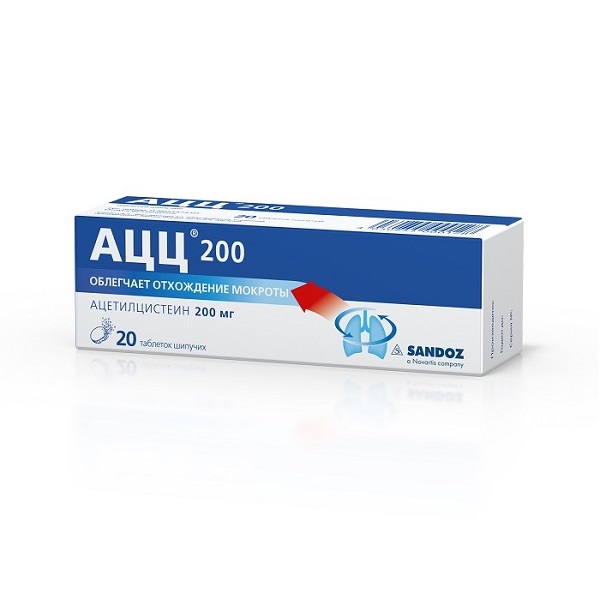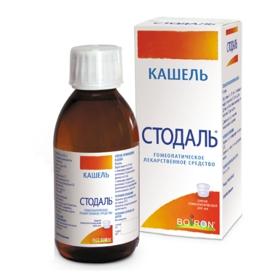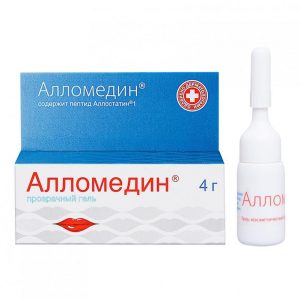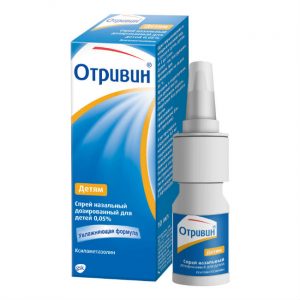Description
Packaging
20 pcs.
Pharmacological action of
Acetylcysteine is a derivative of the amino acid cysteine. It has a mucolytic effect, facilitates sputum discharge due to a direct effect on the rheological properties of sputum. The action is due to the ability to break the disulfide bonds of mucopolysaccharide chains and cause depolymerization of mucoproteins of sputum, leading to a decrease in sputum viscosity. The drug remains active in the presence of purulent sputum. It has an antioxidant effect, based on the ability of its reactive sulfhydryl groups (SH-groups) to bind to oxidative radicals and, thus, neutralize them. In addition, acetylcysteine promotes the synthesis of glutathione, an important component of the antioxidant system and chemical detoxification of the body. The antioxidant effect of acetylcysteine increases the protection of cells from the damaging effects of free radical oxidation, which is characteristic of an intense inflammatory reaction. With the prophylactic use of acetylcysteine, there is a decrease in the frequency and severity of exacerbations of bacterial etiology in patients with chronic bronchitis and cystic fibrosis
Contraindications
hypersensitivity to acetylcysteine or other components of the
preparation peptic ulcer of the stomach and duodenum in the acute stage
pregnancy
lactation, lactation, lactation, laxation,
Children under 2 years of age (for this dosage form).
With caution,
has a history of gastric and duodenal ulcer, bronchial asthma, obstructive bronchitis, liver and / or renal failure, histamine intolerance (long-term use of the drug should be avoided, since acetylcysteine affects the histamine metabolism and can lead to intolerance such as headache, vasomotor rhinitis, itching), varicose veins of the esophagus, adrenal disease, arterial hypertension.
Use during pregnancy and lactation
Data on the use of acetylcysteine during pregnancy and breastfeeding are limited, so the use of the drug during pregnancy is contraindicated. If it is necessary to use the drug during breastfeeding, the issue of its termination should be decided.
Composition
1 effervescent tablet contains:
Active substances: 200 mg acetylcysteine.
Excipients: anhydrous citric acid – 558.50 mg sodium bicarbonate – 200.00 mg sodium anhydrous carbonate – 100.00 mg mannitol – 60.00 mg anhydrous lactose – 70.00 mg ascorbic acid – 25.00 mg sodium saccharinate – 6.00 mg sodium citrate – 0.50 mg blackberry flavor “B” – 20.00 mg.
Dosage and Administration
Inside, after meals.
Effervescent tablets should be dissolved in one glass of water. Tablets should be taken immediately after dissolution, in exceptional cases, you can leave the solution ready for use for 2 hours. An additional liquid intake enhances the mucolytic effect of the drug. For short-term colds, the duration of administration is 5 to 7 days. In chronic bronchitis and cystic fibrosis, the drug should be taken for a longer time to achieve the preventive effect of infections. In the absence of other prescriptions, the following dosages are recommended: Mucolytic therapy: adults and children over 14 years of age: 1 effervescent tablet 2 to 3 times a day (400 to 600 mg)
children 6 to 14 years old: 1 effervescent tablet 2 times a day (400 mg)
children from 2 to 6 years: 1/2 effervescent tablet 2 to 3 times a day (200 to 300 mg).
Cystic fibrosis: children from 2 to 6 years: 1/2 effervescent tablet 4 times a day (400 mg)
children older than 6 years: 1 effervescent tablet 3 times a day (600 mg).
Side effects
According to the World Health Organization (WHO), unwanted effects are classified according to their frequency of development as follows: very often ( 1/10), often ( 1/100, <1/10), infrequently ( 1/1000, <1/100), rarely ( 1/10000, <1/1000) and very rarely (<1/10000) the frequency is unknown (the frequency of occurrence of phenomena cannot be determined based on available data). Allergic reactions infrequently: pruritus, rash, exanthema, urticaria, angioedema, decreased blood pressure, tachycardia very rare: anaphylactic reactions up to anaphylactic shock, Stevens-Johnson syndrome, toxic epidermal necrolysis (). From the respiratory system rarely: shortness of breath, bronchospasm (mainly in patients with bronchial hyperreactivity in asthma). From the gastrointestinal tract infrequently: stomatitis, abdominal pain, nausea, vomiting, diarrhea, heartburn, dyspepsia. Sensory disturbances infrequently: tinnitus. Other infrequently: headache, fever, isolated reports of the development of bleeding due to the presence of an increased sensitivity reaction, decreased platelet aggregation. Drug Interaction When acetylcysteine and antitussive agents are used at the same time, sputum stagnation may occur due to cough reflex suppression. When used with antibiotics for oral administration (penicillins, tetracyclines, cephalosporins, etc.), their interaction with the thiol group of acetylcysteine may occur, which may lead to a decrease in their antibacterial activity. Therefore, the interval between the administration of antibiotics and acetylcysteine should be at least 2 h (except cefixime and loracarbene). Concomitant use with vasodilating agents and nitroglycerin may lead to increased vasodilator action. overdose Symptoms: when mistaken or intentional overdose occurs, such as diarrhea, vomiting, stomach pain, heartburn and nausea. Treatment: symptomatic. Storage conditions The drug should be stored out of the reach of children, in a dry place at a temperature not exceeding 25 ° C. The Expiration of is 3 years. active ingredient acetylcysteine pharmacy leave terms without a prescription Dosage form Dosage form soluble tablets




